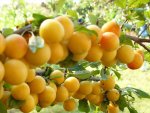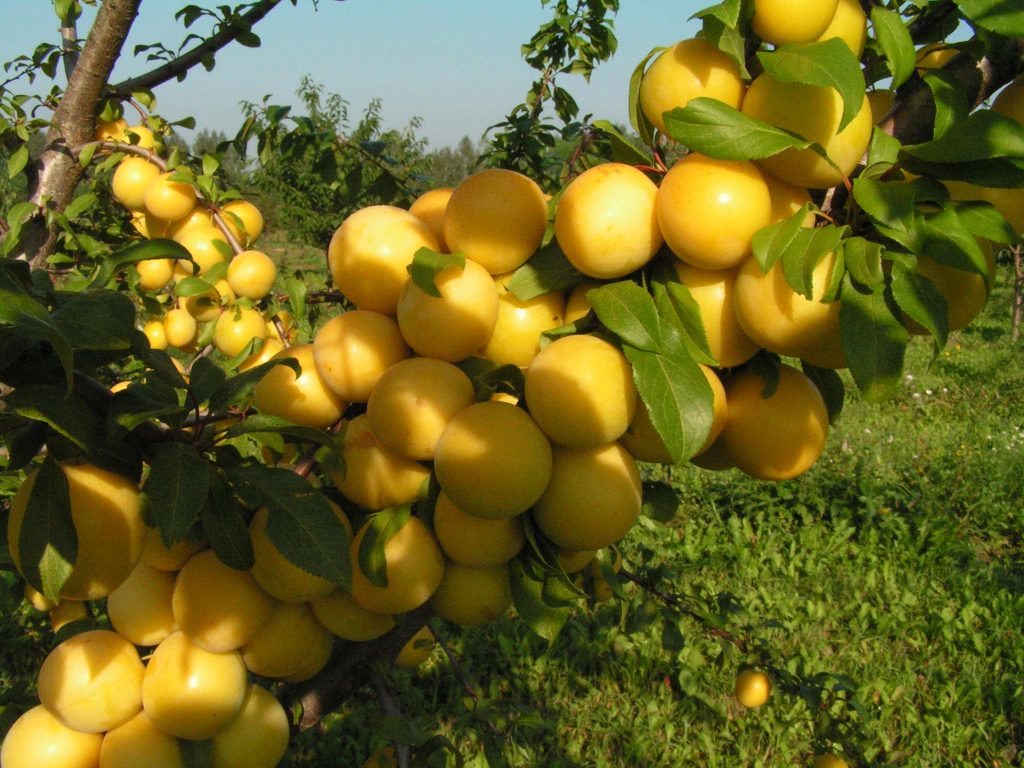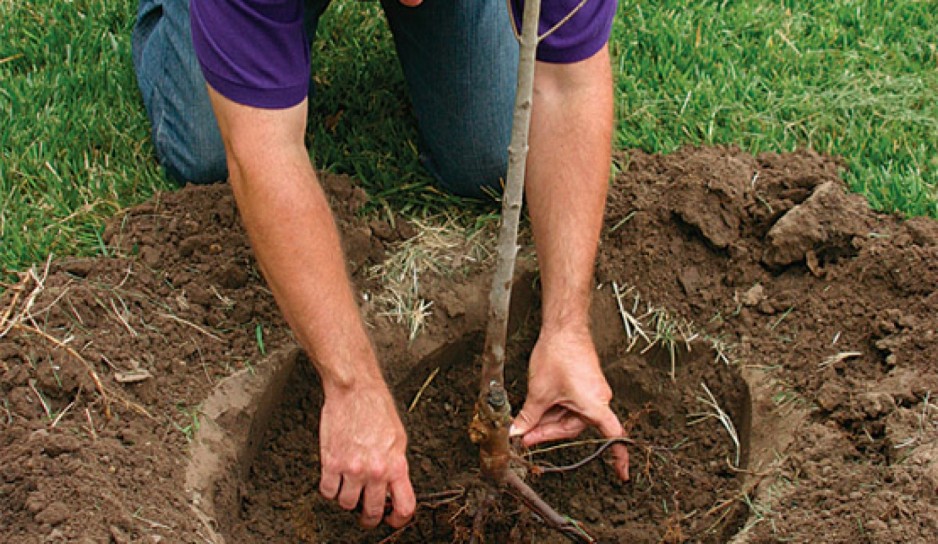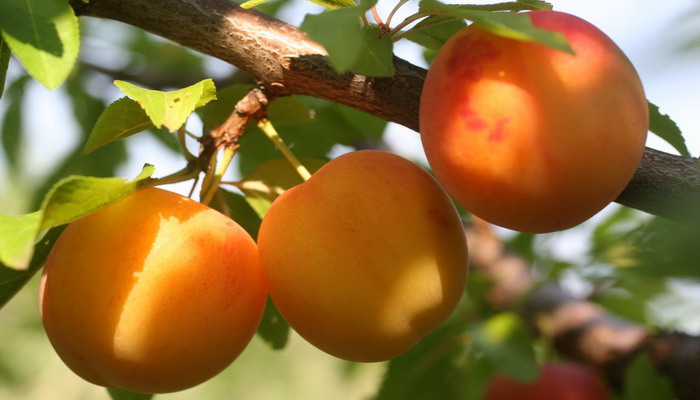Description and varieties of varieties of yellow cherry plum
Content
Description
Green cherry plum is a type of plum that was cultivated by humans several centuries ago. It is believed that the fruit plant "came" to us from the Crimea, the Balkans, Iran and Asia. These territories are characterized by high air temperatures and low rainfall. That is why plum and cherry plum varieties tolerate drought well.
But the most important advantage of the culture is still considered its high fertility. The plant gives the first harvest a year after planting. All subsequent harvests are characterized by regularity and a large number of fruits.
The fruits of the tree have different shapes and colors. Such plums are spherical or oval. Moreover, they have a characteristic yellow, green, red or even purple color.
The characteristic of the tree suggests that its crown can be spreading or have the shape of a pyramid. The branches of the plant are usually "weeping", rather flexible, which allows them not to break under the weight of the fruit.
Some varieties form flowers of 5-10 petals, which are located in 1, less often in 2 layers. The peduncle does not exceed only 4 centimeters in length. However, flowers and fruit ovaries can easily withstand frequent frosts of about -5 ° and a prolonged drop in temperature for 3 days.
Plum fruits usually ripen from mid-summer to mid-September. Some varieties of cherry plum, after fruit ripening, are able to “keep” them on the tree for another month and a half in light frost conditions.
The fruits usually perform both a decorative function and a nutritious one. They have a pleasant taste and a number of substances beneficial to the body.
Video "Description"
From the video you will learn a lot of interesting things about different varieties of cherry plum.
Varieties
Plum is represented today by a number of varieties, which are classified into groups according to certain characteristics.
So, according to the duration of ripening, early, middle and late varieties are distinguished.
Cherry plum is fast-growing, the harvest of which can be harvested already in late July - early August, represented by the varieties Monomakh, Gift to St. Petersburg, Nayden, Traveler, Yarilo, Cherry plum Sigma and Zlato of the Scythians. This group also includes the cherry plum variety Nesmeyan, which is characterized by a spreading, not too thickened crown, as well as early ripening, resistance to cold and frost and a pleasant taste. The description of the variety indicates that its disadvantages can be considered the need to grow a pollinator near (the plant cannot pollinate itself) and average resistance to various diseases.
Mid-season plants usually ripen in August (closer to the middle of the month). Such crops include: peach cherry plum, Sarmatka, Karminnaya Zhukova, Chuk cherry plum.
Late plum varieties ripen in late summer or September. Such crops are represented by the Cleopatra and Gek varieties. The beauty of the Oryol region. In some areas, it is better to refrain from growing late varieties of plums. After all, because of the cold summer, they simply may not ripen.
The cherry plum tree can have different heights. On this basis, varieties are also divided into groups:
- Tall, the height of the individual reaches 6 meters (Anastasia, cherry plum General and Nesmeyana);
- Medium-sized, with a height of 3 to 5 meters: Abundant Cherry, Gold of the Scythians, Cleopatra, Chuk, Gek.
- Stunted, which do not even reach 3 meters: Shater, Kuban Comet.
For regions with a temperate climate, winter hardiness of plants is very important. The Traveler, Gold of the Scythians, Tent tolerate frosts well.
The fruits of the culture can have a variety of colors. Some varieties got their name precisely because of the color of their fruits. For example, cherry plum Apricot, cherry plum lodva, like caramel plum and Byron Gold plum have a yellow-golden color.
Ruby cherry plum has rich red fruits like columnar cherry plum, and Violet Delight has burgundy purple fruits.
Cherry plum forms fruits of different colors: from yellow to blue.
Cherry plum Burbank Giant holds the record for the size of its fruits. One such plum weighs a quarter of a kilogram! These are the largest plums known today.
A significant drawback of most varieties is that they are not self-fertile.
The most important quality of plums is early maturity. For example, cherry plum Avalanche brings rich harvests in the shortest possible time.
Landing features
When planting a culture, there are a number of points to consider.
The culture develops well in areas that are well lit by the sun and protected from the wind. The south-western area of the garden is well suited. In this case, the soil should not be heavy.
When buying seedlings, you should pay attention to their shoots. They must be intact and free of dry areas.
The root system needs careful inspection. It should consist of 5 or more main roots with a length of about 0.2 - 0.25 meters.
Before planting, you need to dig a hole 0.6 mx 0.6 mx 0.6 m and fill it with top dressing: superphosphate and potassium sulfate.
Before burying the seedling, it is worth carefully examining the roots and removing dry or damaged roots. If the roots are brown, they should be cut to a young root (the tissue of the young organ is white). After, the roots are placed in a clay chatterbox and only then are they planted.
Diseases and pests
Cherry plum yellow, like its other "relatives", can be subject to diseases such as brown spot, fungus burn, gum disease, moniliosis, smallpox and rust.
The columnar culture is attractive to a number of parasites - yellow plum sawfly, sapwood, western unpaired bark beetle, subcrustal leafworm, down silkworm. The sweet taste of the fruit attracts the plum moth.
Harvesting
The fruits are harvested after they acquire the proper color, that is, they are ripe. All fruits are harvested at one time, as they ripen at the same time.
The main part of the harvest is consumed fresh. And also plum is actively used to create wine, juice or compote. Fruits ripe in September can be stored for a long time.
For storage, the harvested crop is sorted and laid out in rows in boxes. After that, such containers are placed in a cool room.
So, this variety of plum has a high fertility and a wide range of uses.
Video "Growing"
From the video you will learn how to grow this fruit tree.



